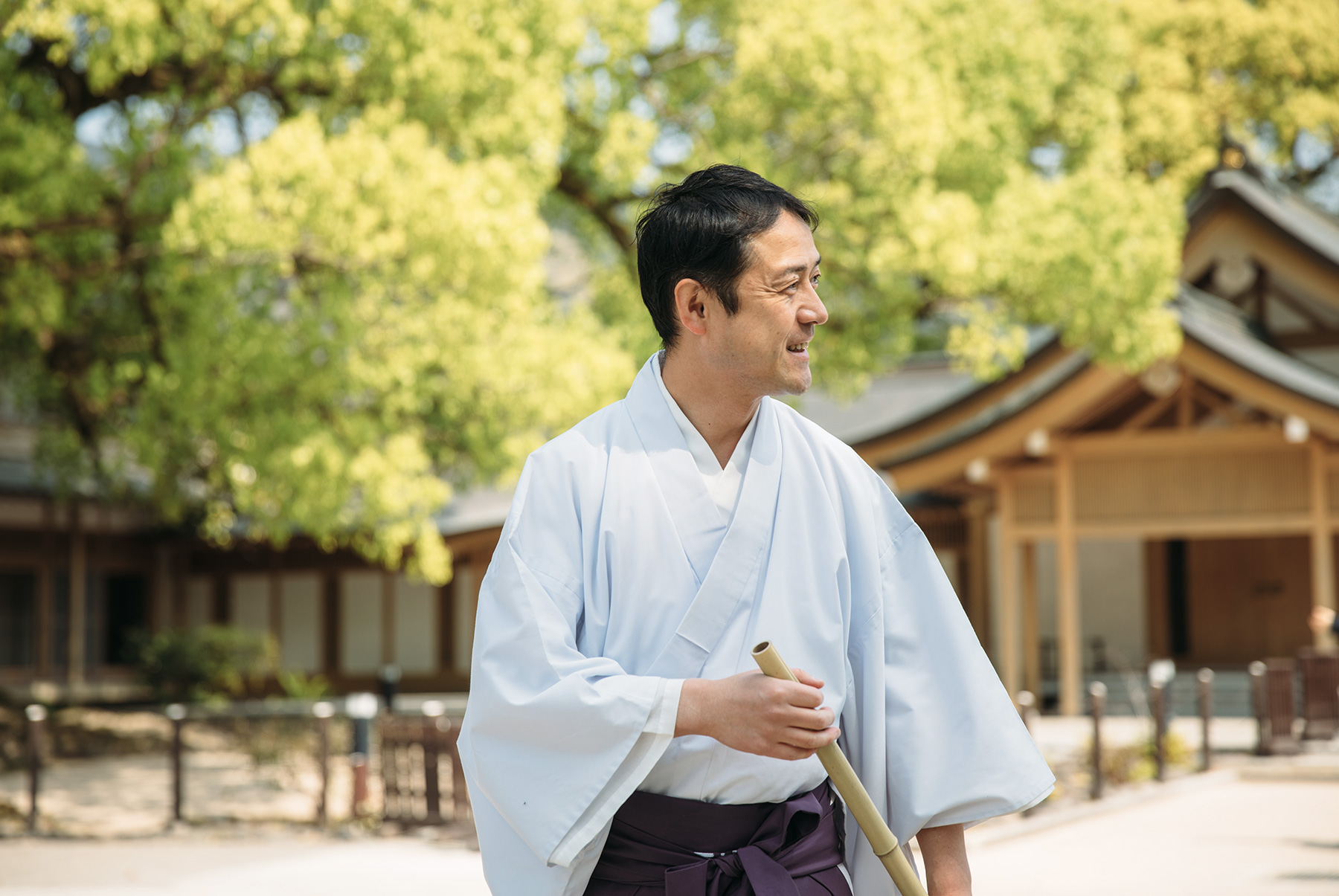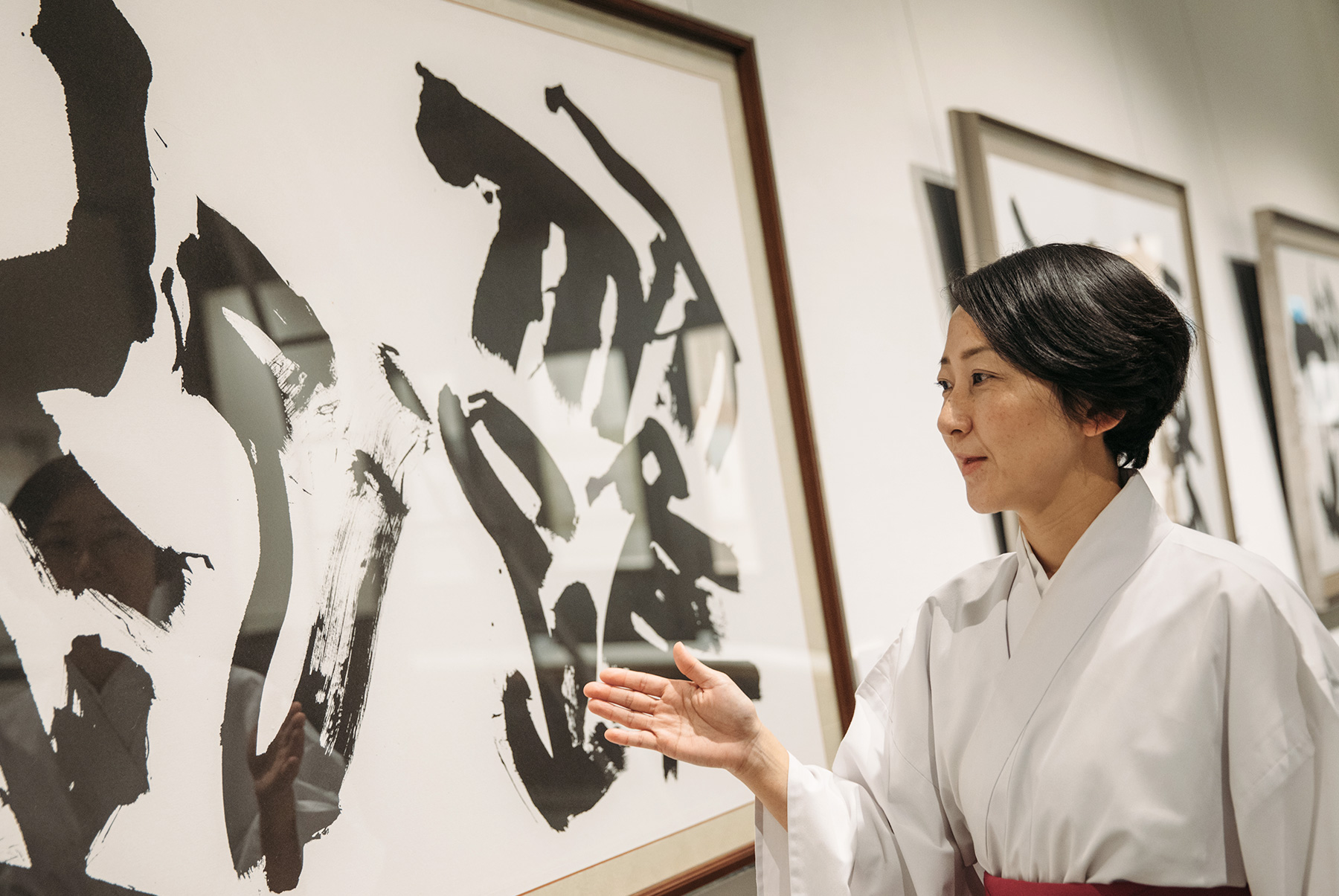DiscoverMeet the People
The Friendly Faces of Dazaifu Tenmangu


Dazaifu Tenmangu is vibrant and full of activity. From cleaning the shrine and its grounds, maintaining the gardens, and curating the art to performing sacred ceremonies, the people who work at Dazaifu Tenmangu bring warmth, energy and faith to the shrine every day. Meet five of the friendly faces that devote themselves to welcoming visitors and preserving the legacy of Sugawara Michizane.




Mori Taro
Mori Taro has served as a priest at Dazaifu Tenmangu for 20 years. His father was also a
priest at Dazaifu Tenmangu and his mother was a researcher at the shrine. Although he didn't
intend to follow in his father’s footsteps, he realized that the shrine represented Japanese
culture in its purest form, and wanted to share that with a wider audience.
What do
you normally wear at the shrine?
Priests normally wear a white robe and hakama pleated pants. For rituals and ceremonies, we
wear another more colorful layer over the top, made of dyed silk. This formal robe is a
traditional design from the Heian period (794–1185).
What’s your favorite spot on the
shrine grounds?
There’s a tall camphor tree over 1,500 years old near the honden. It's a source of
inspiration and encouragement for me, and just gazing up at it, I'm overcome with a sense of
calm. Despite being so old, it gets the most beautiful, fresh green leaves each
spring.
Can you tell us about the festivals held at the shrine?
There are ritual events and festivals all year round, and the two biggest are Sugawara
Michizane's birthday on July 25 and the Jinkoshiki festival which runs from September 21–25.
On the final evening of the Jinkoshiki we hold the Thousand Candles Ceremony, when scores of
lanterns are lit over the taiko-bashi bridges. The finale is the beautiful kagura dance by a
shrine maiden on a special stage set up over the pond.

Misake Yasuyoshi
In his role as a priest, Misake Yasuyoshi assists people in making offerings to Tenjin,
cleans the shrine grounds and prepares for the many rituals and festivals held at the
shrine. This is his hometown, so he has always felt a strong connection with Dazaifu
Tenmangu. When he was younger, he spent some time in Tokyo, but was ultimately drawn back
home.
What do you like about working here?
The chance to experience Japan’s four
seasons with my five senses. The scenery and scents change even within a single season, and
the weather, sunlight, trees, and flowers are always changing. The shrine and its
surroundings feel alive.
When is the best time to visit?
It’s always a good time
to visit, but I recommend February to March, when the shrine's several-thousand plum trees
bloom. The plum blossoms in the crisp morning air of late winter are beautiful, and as the
temperature rises towards noon, the scent of plum blossoms drifts through the
grounds.
Do you have a favorite spot at the shrine?
One of my favorite spots here
is Kita Shinen garden, behind the main sanctuary. It has a tranquil atmosphere, and you can
have tea and umegaemochi sweets in the teahouses there. Make sure you visit hungry so that
you can enjoy these tasty treats.

Kinoshita Izumi
Kinoshita Izumi is a miko, or shrine maiden. She wears a white robe with a red, floor-length
hakama skirt. You will often find her staffing one of the shrine's amulet counters or
performing in a traditional ceremony. She enjoys helping visitors connect to Tenjin and
choose the best amulet for their needs. She is a talented calligrapher and kagura performer.
She performs kagura dance for ceremonies and special occasions.
What do you like
about working at Dazaifu Tenmangu?
There’s always something happening here and the
grounds are beautiful. Of course, plum blossom season in February and March is lovely, but
sunny days in late spring and early summer are my favorite—the young leaves of the trees in
the grounds appear the most vibrant green. I also enjoy being able to help and bring
happiness to the people that visit the shrine.
What is something people might not
know about the shrine?
A lot of people don't know about Tenkai Inari Shrine, a short
distance behind the main sanctuary. It's a nice walk and the path is straddled with red
torii gates. Follow the path and climb the stone stairs to reach the shrine, which is known
locally for its spiritual energy.
Can you tell us more about the kagura dance?
It takes a lot of practice, and we are accompanied by the Japanese classical flute and the
Japanese harp. It’s not a dance for entertainment but a dance of worship to Tenjin, so it’s
important to perform well. I feel an enormous sense of achievement after I complete it.


Koga Yoshinori
As a landscape architect, it is Koga Yoshinori’s job to tend to the plants and trees here,
especially the 6,000 plum trees, of 200 different varieties. Pruning is a very important
skill, and you will often see the gardeners up ladders, shaping the trees. They wear a
uniform including traditional tabi-style shoes, which are flexible for climbing.
What
do you like most about your work?
It’s satisfying to see the plum trees in bloom after taking care of them all year. They're
the hardest trees to look after here, and some of them are very old. They bloom from
mid-January through early March, and are really worth seeing.
Why did you choose this
work?
I've always been interested in gardening. I like being surrounded by green and it
gives me an opportunity to feel nature and the changing seasons.
When are you at your
busiest?
I'm at my busiest from July through January, when I'm pruning and getting the
gardens ready for the coming spring.
What do you recommend for visitors to the
shrine?
I recommend taking a leisurely walk through the grounds, stopping to look at the plants and
flowers, especially the camphor trees. There are more than 100 camphors and they are all
very old. Some of the oldest are more than 1,500 years old and predate even the shrine. It's
amazing to think they have stood watch over Dazaifu Tenmangu for so many years.


Anderson Eri
As a curator at Dazaifu Tenmangu Shrine Institute for Art and Culture, Anderson Eri works
closely with visiting artists, and manages the art and cultural properties. Sometimes, you
will also see her guiding visitors and helping at the amulet counters, wearing a white robe
and a deep-red floor-length hakama skirt.
What do you like about your work?
The
opportunity to meet many people; one encounter can open many new doors.
What is the
connection between Dazaifu Tenmangu and the arts?
Sugawara Michizane, or Tenjin, is
worshipped as the deity of learning, culture, and the arts. He was at the center of
cutting-edge art and culture in his day. The shrine held the Dazaifu Expo in 1873, 1874, and
1875 to honor that connection. We've brought back that idea with the Dazaifu Tenmangu Art
Program, which has been running since 2006, to bring art to the present generation. We work
with the Kyushu National Museum, continuing Tenjin’s role as a supporter of culture and the
arts.
Do you have a favorite object in the museum?
With 50,000 pieces, it’s hard
to choose a favorite! But I like Brush Tenjin by Kagoshima Juzo, a master craftsman and a
Living National Treasure. He made an exquisite doll of Tenjin, crafted from washi paper and
dedicated to Japan's three greatest calligraphers, Sugawara Michizane, Ono Tofu and Kukai.
It has a hat shaped like the tip of a calligraphy brush. It's not one of the permanent
exhibits, but if you're lucky you may get a chance to see it. It's a small piece, but it
makes quite an impression.
What is one of your most interesting art projects at
Dazaifu Tenmangu?
Ryan Gander’s New New Day project. Ryan proposed coming up with a new
day of celebration for Dazaifu Tenmangu while holding his solo exhibition, You have my word,
at the shrine in 2011. Since then, we've been celebrating New New Day each year on March 16.
It's an examination of Shinto and purity through icons like a bride’s white kimono, and
salt, used for purification. The concept is to paint familiar objects white, to help us see
them in a new way. It's a day for us to rethink the things around us and their importance.
